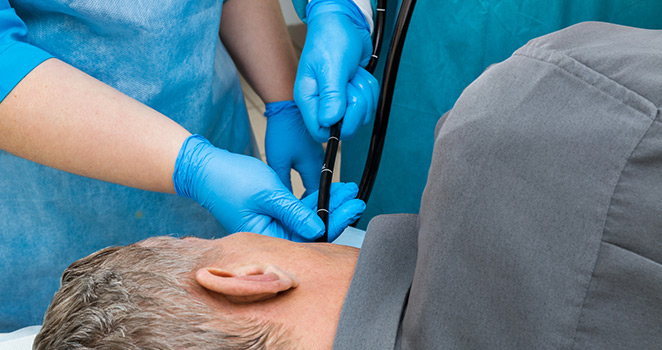Atrium Health Navicent Gastroenterology
Upper Endoscopy

Upper endoscopy, usually known as EGD or esophagogastroduodenoscopy or endoscopy is a procedure that doctors use to examine the top portion of the gastrointestinal tract (GI). The upper part of a GI includes the esophagus, the stomach, and the duodenum. An elastic, lighted tube, with a camera at its end is inserted into the patient's mouth through the stomach, into the duodenum.
The doctor performing EGD must have specialized training on how to use an endoscope to diagnose conditions that affect the upper GI. The procedure may be carried out in a doctor's office, an emergency room or a hospital.
Why is it Performed?
- Swallowing difficulties
- Bleeding
- Heartburn
- Abdominal or chest pains
- Nausea and vomiting
It is also used to assess the stomach or esophagus after a major surgery. It is more precise than X-ray in identifying inflammation and abnormal growths such as cancer and tumors. EGD can detect without fail whether a growth is cancerous or not, by carrying out biopsies on sample tissues.
Besides diagnosis, a number of conditions may be treated, including:
Your doctor can stretch narrowed areas of the upper GI using balloons or any other appropriate devices.
- Removal of swallowed objects
- Removal of polyps (tissue growth in the stomach)
- Treatment of bleeding due to cancer, ulcers and any other condition
Upper Endoscopy Preparation
While scheduling for your EGD, let your doctor know if you are allergic to any medications, have heart or lung issues, or if you are pregnant. It is important for the physician to be aware of your full medical history so as to avoid any complications.
One should not eat or drink anything eight hours before the procedure. Your surgeon will tell you the specific time that you should fast, depending on the time that the test is arranged. It may be necessary to adjust or avoid some medications. For instance, if one is taking Vitamin E, Aspirin, Insulin, Blood thinners or non-steroidal inflammatory, they should inform the surgeon before the examination. If you use antibiotics during dental procedures, alert the doctor as you may have to use them during EGD.
Arrange for a taxi or means to get you home after the examination. The sedation given may cause dizziness and drowsiness thus impairing your judgment and consequently making it unsafe to operate machines or drive within eight hours after the procedure.
Endoscopy Procedure
Before setting off, the doctor will explain the procedure in detail and respond to any concerns that you may be having. You might be asked to put on the hospital gown, and remove dentures and eyeglasses. A local anesthetic might be sprayed on your throat and you may be given a pain reliever and sedative to help you be calm and feel drowsy.
You will be asked to lie on your back or side as the endoscope is passed through your upper gastrointestinal tract gently. Air is pumped into your stomach to permit a better view of the stomach lining. Usually, the procedure lasts for about 15-60 minutes. The endoscope will not alter your breathing. Most patients fall asleep during the examination and only a few find it uncomfortable.
What to Expect After the Procedure?
You will stay in the recovery room under observation until the sedatives have worn off. You may have a sore throat for about a day or two; lozenges might help. It is possible for the patient to feel bloated because of the air that was pumped in the stomach. You can take your routine medicine and resume your diet once you leave the endoscopy area, unless instructed otherwise. Your doctor will inform you of the outcome of the procedure about a day after the tests, unless a biopsy was taken. Biopsy results may take a number of days to return.
EGD - The Risks
Generally, gastroscopy is safe when performed by a surgeon who has received specialized training and is experienced in such procedures. Although complications are uncommon, they can occur. A patient may experience bleeding from the site of polypectomy or biopsy. There may be a tear in the intestinal lining. In such cases, transfusion is rarely needed as they are not extreme.
The patient might react to the sedatives. Irritation on the veins where the sedative is administered is rare, but a tender lump may appear. The lump may last for a few weeks. Warm, moist cloths might help relieve the discomfort.
It is crucial to contact your surgeon if you notice any possible complication arising from the procedure. If you experience severe abdominal pains, fevers, chest pains, chills, difficulty in swallowing, or worsening through pain, consult your surgeon.